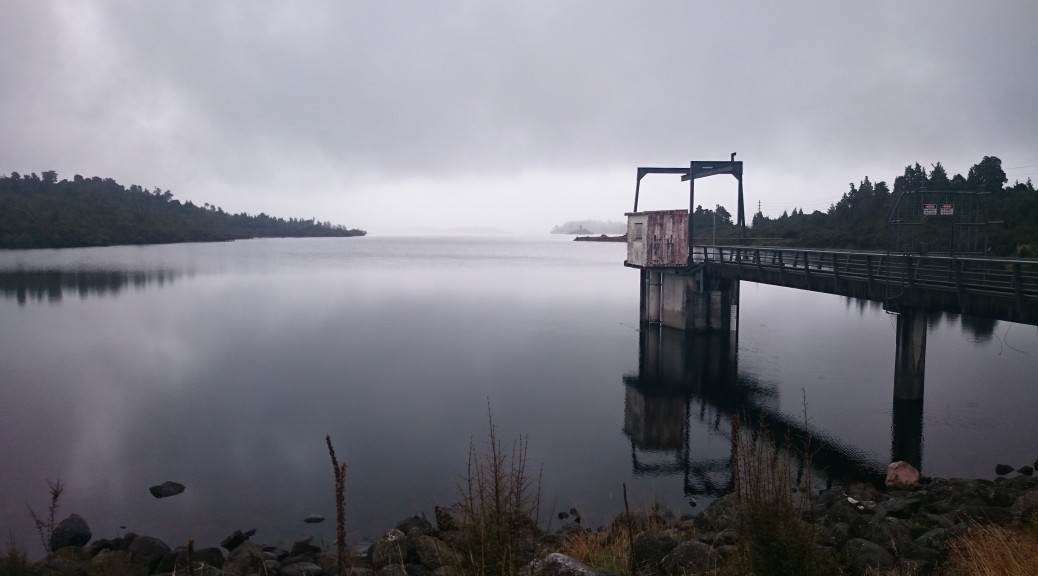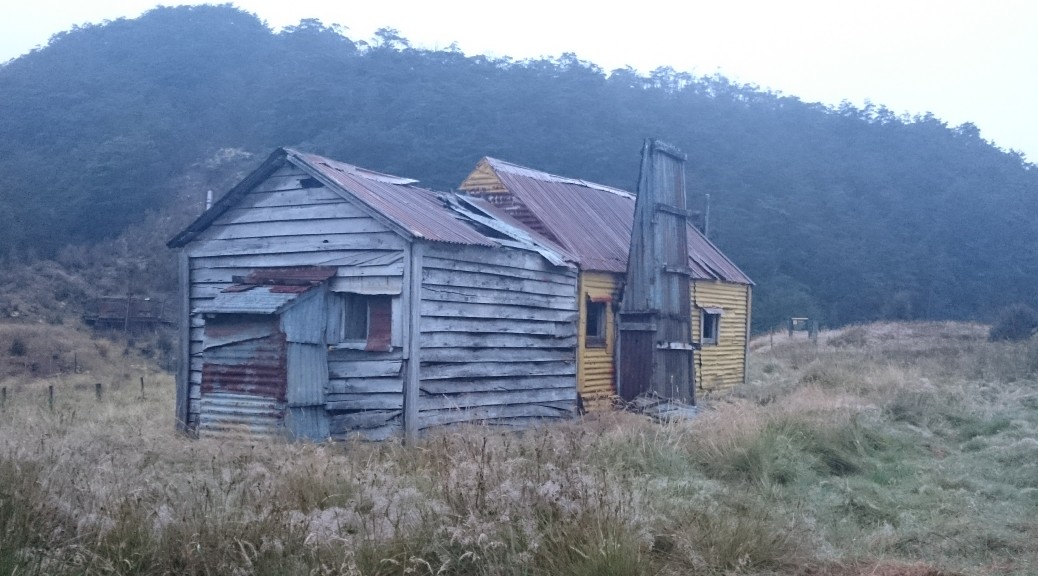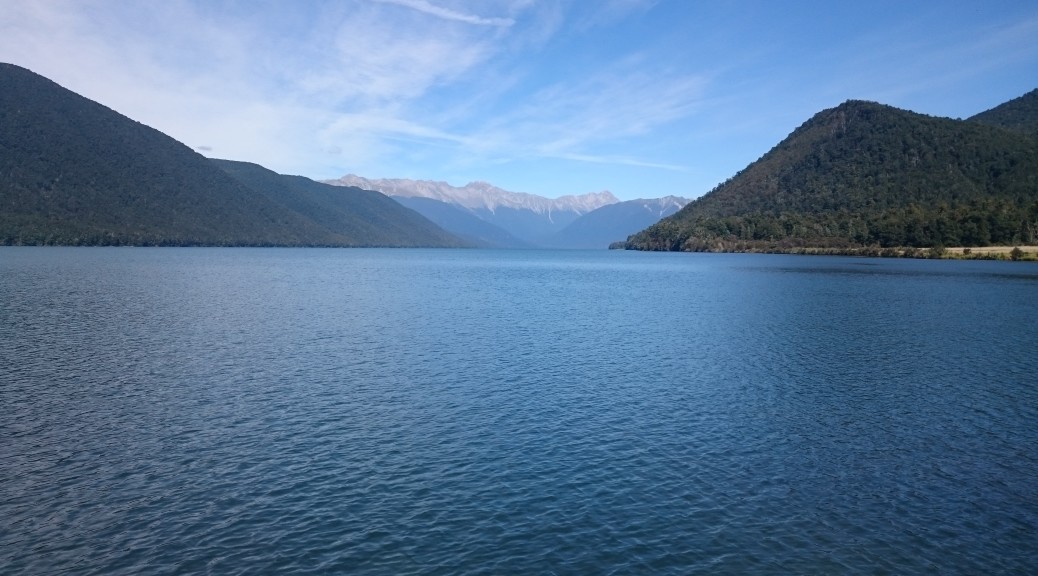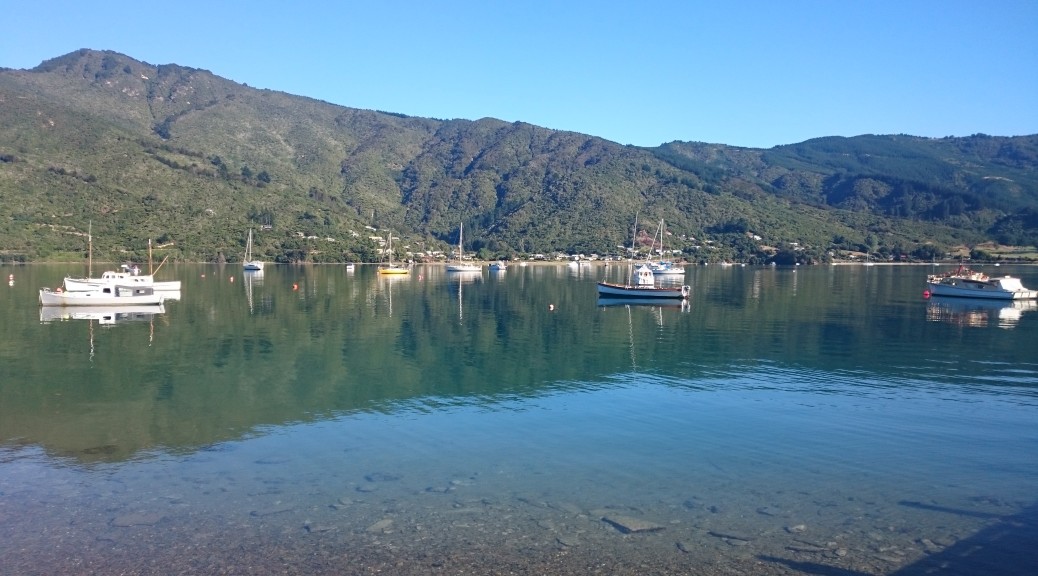There was no way I was advocating a ride of the beautiful, yet very slippery, Waiuta track in the dark. So we got up at a normal hour and were riding around sunrise at about quarter past seven. It was a grey, damp morning as the cloud was low – but not wet enough to have to wear a jacket, nice.
 Looking down to Big River from the hut; it’s not far from Reefton really, but feels a world away.
Looking down to Big River from the hut; it’s not far from Reefton really, but feels a world away.

 Within ten or so minutes we were on the boardwalk for another checkpoint.
Within ten or so minutes we were on the boardwalk for another checkpoint.
 Hopefully you can get a sense of the denseness of the forest that the trail goes through. Apparently residents of Big River used to walk two hours each way to Waiuta to go to the cinema on Sundays – they must have been desperate for some diversion.
Hopefully you can get a sense of the denseness of the forest that the trail goes through. Apparently residents of Big River used to walk two hours each way to Waiuta to go to the cinema on Sundays – they must have been desperate for some diversion.
This old mining pack track is open to bikes, but definitely not designed for bikes. It is very damp and every rock is slippery – and there are plenty of those. It was pretty slow progress to get up and continue along at about the same altitude for some kilometres.
 This is a good bit of trail.
This is a good bit of trail.
 Suddenly, the trail is a creek bed. At times it looks other worldly.
Suddenly, the trail is a creek bed. At times it looks other worldly.
 Then it just becomes easier to push one’s bike up the creek.
Then it just becomes easier to push one’s bike up the creek.
At some stage, I’d let Adele go on ahead while I made some bike or luggage adjustment. It took me a little while to catch up. When I did, just the slightest distraction of seeing another rider was enough to remind me of the total concentration that this trail demands. Front wheel sliding and stopping suddenly was enough to send me flying off the bike and over the edge of the bank. It was by far my biggest fall of the Tour, but thankfully the landing was soft in amongst the ferns and no damage was done. I think Evan made the comment later it was nice to be going through there in the company of a doctor – I’d not considered that, but it was true.
 The trail flattened out a bit and became less rocky. But there were still frequent creek crossings and one big washout that required a carry – I almost lost my bike, and myself, down the debris field. Oops.
The trail flattened out a bit and became less rocky. But there were still frequent creek crossings and one big washout that required a carry – I almost lost my bike, and myself, down the debris field. Oops.

 The sun even tried to break through at some stage.
The sun even tried to break through at some stage.
Eventually, we’d put enough work in and we were rewarded with a two-hundred metre drop in altitude. I was waiting at Adele’s car for a little while before it was quickly packed, goodbyes said and Adele took off to work. Even looking a month later, I’m a little sad that I can’t ride that trail more often – it’s rugged, it feels very remote and is in an area filled with fascinating mining history. What a fantastic day and a bit of intermittent bike adventuring with Adele.
Evan was keen to check out the old town of Waiuta – which is well worth it, as I’ve enjoyed poking around the mining and social relics before – so I carried on alone. The gravel road down out of the valley to Blackwater and Ikamatua was fast – so much better than the ride up when doing these trails in the other direction. To my delight, the little store in Ikamatua was open for second-breakfast. I think the storekeeper there had been doing well out of all these cyclists coming out of the Big River wilderness.
Crossing the Grey to the right bank, it was a very gradual descent (mostly) to the coast. Passing the turn-off to the Pike River memorial and then Blackball, I made reasonable time before a light rain set in. I was overly excited to be able to buy nashi pears from a roadside stall in Taylorville.
 The whole NZ army did seem to be staying in a village hall along the way.
The whole NZ army did seem to be staying in a village hall along the way.
Stocking up and then eating lunch in Greymouth, it was then time to start the West Coast Wilderness Trail – the part of the South Island route I was most looking forward to riding. I’d heard it is absolutely stunning. It rained the whole trail and I saw little. I minded little as my easy and social start to the South Island was now over and I had to start putting in some bigger days. I’d gotten a text from Dad saying that he couldn’t actually pick me up on the day I was looking most likely to finish. The possible implications of this weighed heavily on my mind; it’s very easy to obsess when you’ve not much else to think about except ride, eat and sleep. I didn’t want to go slower as that would leave no rest before returning to work and I wanted to push myself a little bit. But finishing a whole day earlier would be a big effort, especially with all the rain forecast over the next few days. I continued to think this over, and over.
What I did see of the West Coast Wilderness trail was very nice and the riding is pretty easy – so I made good time in the rain. I hope I have the chance to ride it again and see more.

 Easy riding into Kumara.
Easy riding into Kumara.
 A reservoir out of the mist!
A reservoir out of the mist!
The trail took almost forty kilometres to climb only three hundred and fifty metres up and out of one valley, before dropping into the next valley and heading back to the coast again. The rain continued to fall as I descended for three hours – thankfully never cold – it was definitely very wet rain.
 Probably the only steep-ish bit on the whole trail.
Probably the only steep-ish bit on the whole trail.
 Out of the wilderness, to some degree, and along gravel roads for some time.
Out of the wilderness, to some degree, and along gravel roads for some time.
I was relieved to arrive in Hokitika before it got dark. Looking like the proverbial drowned rat, a friendly Subway was the easiest option for dinner. It was coming up to the Wildfood Festival and accommodation was at a premium – I was pleased when Evan turned up and confirmed he’d booked a cabin. I was even more thrilled when he let me sleep on the floor of his cabin. While only just over 180 km for day, none of it in the dark, and with little climbing – it felt like a big day with the rain for a hundred kilometres and the two hours to travel eleven kilometres to Waiuta. Almost everything was soaked, we hung as much as we could up to dry – without high hopes – and slept very well as the famous West Coast rain fell all night.
 Another wet West Coast photo checkpoint, in Hokitika.
Another wet West Coast photo checkpoint, in Hokitika.





 We even got a picture together, not as frequent an occurrence as either of us would like.
We even got a picture together, not as frequent an occurrence as either of us would like. Looking back along another quiet West Coast highway.
Looking back along another quiet West Coast highway. Just a bike picture at the rather agreeable saddle.
Just a bike picture at the rather agreeable saddle. “Road Closed Use At Own Risk” – I think this road hasn’t been maintained for a very long time.
“Road Closed Use At Own Risk” – I think this road hasn’t been maintained for a very long time.  Big River looking rather benign – this can rise very quickly and did a few days later. So much so, that the Big River-Waiuta part of the course became optional.
Big River looking rather benign – this can rise very quickly and did a few days later. So much so, that the Big River-Waiuta part of the course became optional. Old cyanide tanks for the leaching part of the operation.
Old cyanide tanks for the leaching part of the operation. Looking around for the hut, which I vaguely remembered passing last year, I was hopeful that this wasn’t it.
Looking around for the hut, which I vaguely remembered passing last year, I was hopeful that this wasn’t it. Perhaps one day I’ll return to have a proper look around the old mining equipment that is further off our route.
Perhaps one day I’ll return to have a proper look around the old mining equipment that is further off our route. One only had to look up and see the hut prominent as the night drew in.
One only had to look up and see the hut prominent as the night drew in.

 Rolling into Wakefield.
Rolling into Wakefield. Heading up to Dovedale.
Heading up to Dovedale.
 There were plenty of old buildings to see; this one unusually was having a lot work done on it.
There were plenty of old buildings to see; this one unusually was having a lot work done on it. Leaving the highway and crossing the Buller River.
Leaving the highway and crossing the Buller River. Another photo checkpoint – Lake Rotoroa.
Another photo checkpoint – Lake Rotoroa. The sandflies are notorious here.
The sandflies are notorious here.

 Leaving Picton
Leaving Picton Up on the optional trail.
Up on the optional trail. Also on the optional bit.
Also on the optional bit.  No dolphins this year at Grove, much to my disappointment. That dusk sighting is an enduring memory of last year’s Kiwi Brevet.
No dolphins this year at Grove, much to my disappointment. That dusk sighting is an enduring memory of last year’s Kiwi Brevet.
 We went where the powerlines ended up, thankfully not by the same route.
We went where the powerlines ended up, thankfully not by the same route. The trail before it got steeper and looser – still pretty steep at this point.
The trail before it got steeper and looser – still pretty steep at this point. Hard to believe I was at sea-level but twenty kilometres before – that’s quite a few hills in amongst the sea.
Hard to believe I was at sea-level but twenty kilometres before – that’s quite a few hills in amongst the sea.  We dropped down to this reservoir, before having to steeply climb a short distance before it was mostly gently down the Maitai Valley to Nelson.
We dropped down to this reservoir, before having to steeply climb a short distance before it was mostly gently down the Maitai Valley to Nelson.